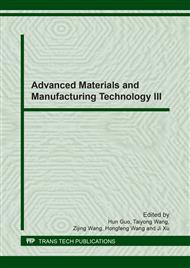[1]
Martellotti M E. An analysis of the milling process[J]. Transactions of the ASME, 1941, 63: 677-700.
Google Scholar
[2]
Martellotti M E. An analysis of the milling process, Part2 down milling[J]. Transactions of the ASME, 1945, 67: 233-251.
DOI: 10.1115/1.4018229
Google Scholar
[3]
Zhu R, Kapoor S G. Mechanistic modeling of the ball end milling process for multi-axis machining of free-form surfaces[J]. Journal of Engineering for Industry, 1991, 113(2): 160-168.
DOI: 10.1115/1.1369357
Google Scholar
[4]
LOTFI S, BOUZID W, ZGHAL A. Chip thickness analysis for different tool motions for adaptive feed rate [J]. Journal of Materials Processing Technology, 2008, 204:213-220.
DOI: 10.1016/j.jmatprotec.2007.11.094
Google Scholar
[5]
RAO V S, RAO P V M. Modelling of tooth trajectory and process geometry in peripheral milling of curved surfaces [J]. International Journal of Machine Tools &Manufacture, 2005, 45: 617-630.
DOI: 10.1016/j.ijmachtools.2004.10.004
Google Scholar
[6]
Kang Y H. Zheng C M. Mathematical modelling of chip thickness in micro-end-milling: A Fourier modelling [J]. Applied Mathematical Modelling, 2013, 37: 4208–4223.
DOI: 10.1016/j.apm.2012.09.011
Google Scholar
[7]
Liao Dong. Cutting thickness model comparison considering cutting tool deflection in micro -milling[J]. Journal of Drainage and Irrigation Machinery Engineering, 2015, 33(3): 273–276.
Google Scholar
[8]
Yuan P, Ke YL, Dong YH. Trochoid-path-based FEM simulation for high-speed milling of aluminum alloy [J]. Journal of Zhejiang University, 2009, 43(3):570-577.
Google Scholar
[9]
Yang Y, Wan M, Zhang W H, et al. Chip Thickness Analysis in Peripheral Milling of Curved Surfaces with Variable Curvature Considering Cutter Runout[J]. Materials Science Forum, 2011, 697-698: 75-79.
DOI: 10.4028/www.scientific.net/msf.697-698.75
Google Scholar
[10]
Xue Y. Model of the Instantaneous Unreformed Chip Thickness in Milling Based on Real Tooth Trajectory[J]. Journal of Mechanical Engineering, 2011, 47(1): 182.
DOI: 10.3901/jme.2011.01.182
Google Scholar
[11]
ENGIN S, ALTINTAS Y. Mechanics and dynamics of general milling cutters. Part I: Helical end mills[J]. International Journal of Machine Tools & Manufacture, 2001, 41: 2195-2212.
DOI: 10.1016/s0890-6955(01)00045-1
Google Scholar


